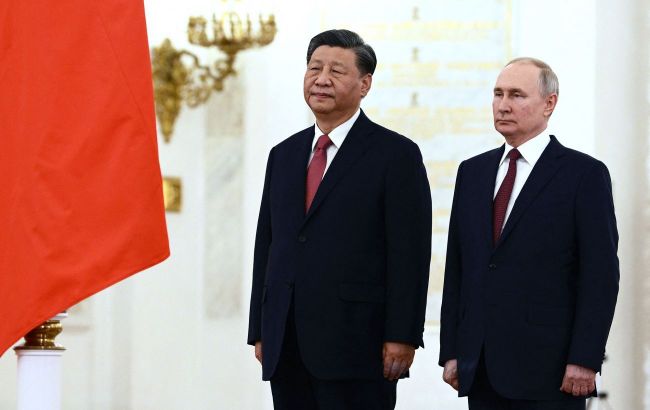Russia developing kamikaze drone with Chinese engine - Reuters
 Photo: Putin and Xi Jinping (Getty Images)
Photo: Putin and Xi Jinping (Getty Images)
Russia has begun production of a new long-range strike drone called Garpiya-A1 (Harpy). It utilizes a Chinese engine and components, Reuters reports.
According to Reuters sources, the new drones are being produced by Izhevsk Electromechanical Plant Kupol, a subsidiary of the Russian arms manufacturer Almaz-Antey. It is reported that over 2,500 Garpiyas were manufactured from July 2023 to July 2024.
Sources from the agency claim that Russia has already used the Garpiya against both military and civilian targets in Ukraine. The sources also provided news agency with photos purportedly of the new drone, but Reuters could not verify the authenticity of the images.

Photo: purportedly a new Russian drone (Reuters)
According to Samuel Bendett, a senior fellow at the Center for a New American Security, if the production of the Garpiya is confirmed, it would allow Russia to reduce its reliance on Iranian long-range drone developments.
"If this is happening, it could indicate that Russia can now rely more on domestic development as well as, obviously, on China, since both sides in this war depend on many Chinese components for drone production," he believes.
What is known about the Garpiya
According to Reuters, the new drone is "roughly similar to the Shahed" but has a few distinguishing features.
In particular, it has a unique fin mounted with bolts and Limbach L-550 E engines. This engine was initially developed and manufactured by a German company but is now produced in China by the local firm Xiamen Limbach.
The takeoff weight of the Garpiya is less than 300 kilograms, and its maximum flight range is 1500 kilometers. This is stated in the production contract between the Kupol company and the Russian Ministry of Defense. These parameters match those of the Iranian Shahed-136 drones, which Moscow has actively used in Ukraine.
The engine manufacturing company did not respond to the agency's inquiry about the use of their parts.
Use of Chinese components
According to Reuters' analysis, the new drones are likely being produced at a former cement plant located in Izhevsk, in western Russia. This plant was acquired by the Kupol company in 2020. The prototype of the Garpiya was likely launched in the first half of 2023, and by the second half of 2023, production had reached several hundred units. In 2024, production doubled to approximately 2,000 units.
Corporate documents dated to the second quarter of 2023, reviewed by Reuters, indicate that parts for the drones were sourced from Chinese companies. This includes 800 Chinese engines that were delivered to the new plant.
In the third quarter of this year, Vector and Kupol ordered 100 axles, carburetors, and other Limbach engine parts from the Chinese companies Juhang Aviation Technology and Redlepus Vector Industries.
It is worth noting that Juhang was subject to British sanctions in February and American sanctions in May for supplying Russia with drone equipment.
From April 2022 to December 2023, Vector imported goods worth $36.3 million from Chinese Juhang Aviation Technology and $6.2 million from Redlepus TSK Vector Industrial Shenzhen Co Ltd. According to customs documents, the goods included aviation engines, transistors, electronic modules, connectors, plugs and sockets, spare parts, and components, most of which were labeled as "for general civil purpose," "for general industrial purpose," or "for general civil use."
China accused of military assistance to Russia
In July, US Secretary of State Antony Blinken accused China of being a major supplier of weapons to Russia's defense industry. The US was particularly concerned about the new ways China and Russia have found to collaborate.
At the same time, NATO leaders issued a joint declaration identifying China as a "decisive enabler" of Russia's war against Ukraine.
Chinese companies are suspected of supplying Russia with dual-use goods that could be used in weapons production. Notably, Associated Press reported in April about a sharp increase in such trade.
On July 31, China adjusted its export controls on drones intended for military use, as Beijing faced growing criticism from the US and its allies over its support for Russia's war against Ukraine.

